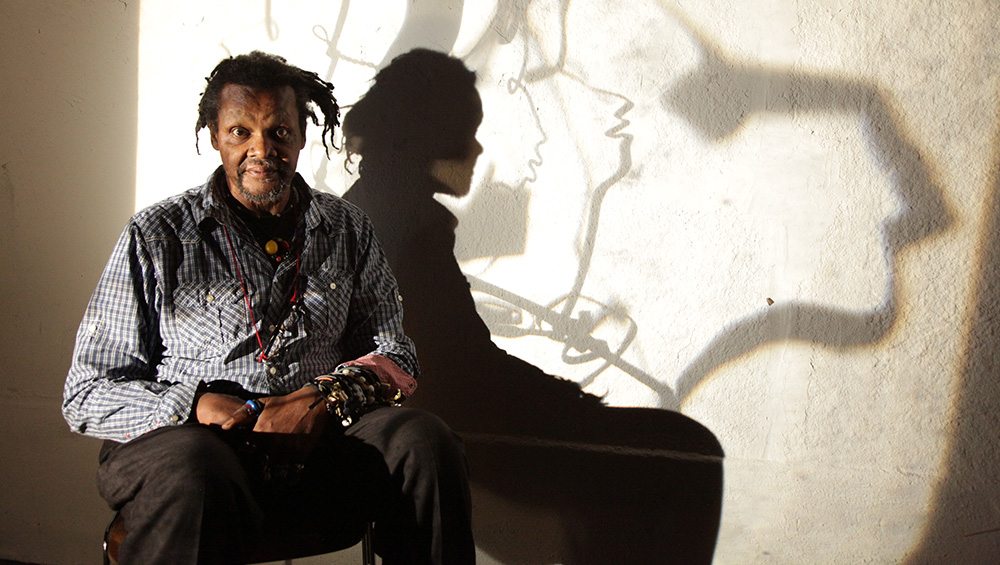
Lonnie Holley in Marfa, Texas, 2017. Photo: Victoria Warren.
by ELIZABETH FULLERTON
In non-coronavirus times African American artist Lonnie Holley might be found in his adopted hometown of Atlanta, twisting a piece of wire into a profile and attaching it to a tree on a roadside as a gift to passersby. Or scouring a landfill or creek or railway track for debris that he transforms into poetic assemblages. These antisocial spaces have been a source of beauty and inspiration throughout Holley’s life, offering transcendence from its many tribulations.
The seventh of 27 children, Holley was born in 1950 in Jim Crow-era Alabama, taken from his mother by a burlesque dancer and apparently traded on for a pint of whisky when he was four. Growing up in a whisky house, he was regularly beaten by his foster father, ran away, got hit by a car and declared brain dead, ran away again and was interned at the age of 12 in the notorious Alabama Industrial School for Negro Children, where the youngsters were worked like slaves. When he was 29, his sister’s home burned down killing two of her children; they couldn’t afford gravestones, so he carved some out of industrial sandstone and discovered a latent well of creativity within. Since then, Holley has been constantly making art, a vital act of catharsis. “If he hadn’t found art, he would have most certainly found death,” says Matt Arnett, Holley’s manager and collaborator, whose father, the collector William Arnett, has championed Holley and other African American artists from the deep south.
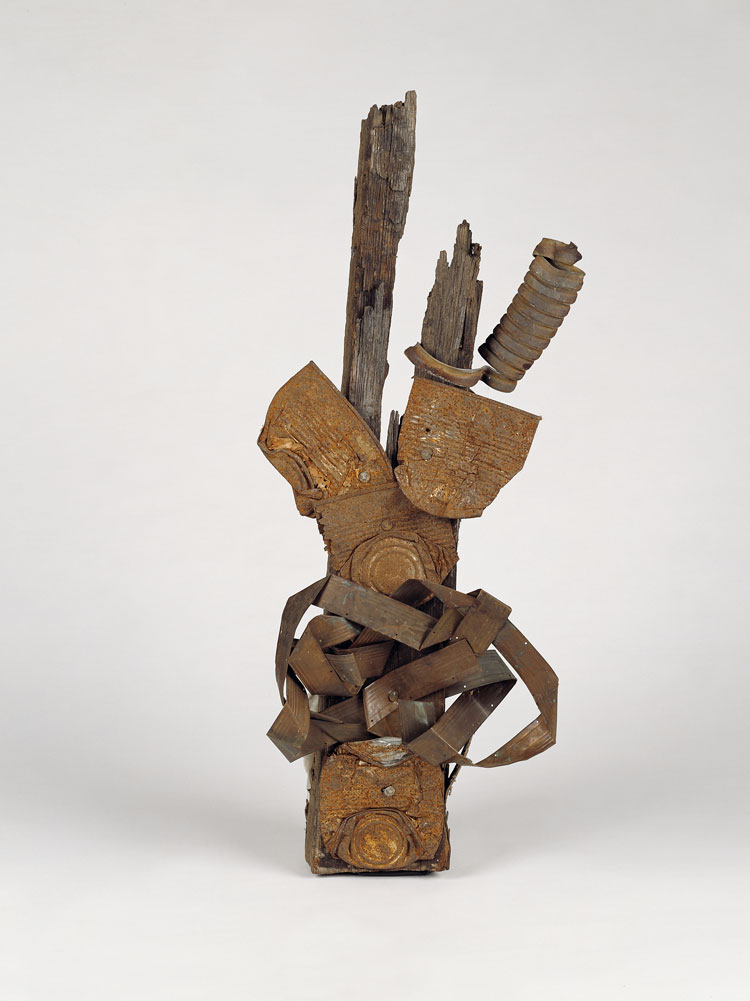
Lonnie Holley. Surviving Hunger, 1997. 27 x 13 x 9 in. Collection: Souls Grown Deep Foundation. © Lonnie Holley / Artists Rights Society (ARS), New York. Photo: Stephen Pitkin/Pitkin Studio.
Holley’s repurposed assemblages are profoundly personal, while offering a forceful commentary on our profligate consumer culture. Surviving Hunger, from 1997, is made from flattened rusted food cans nailed to a wooden plank and an almost unrecognisable dusty plastic water bottle, all brown with grime and time. Cold Titty Mama (1999) resembles a 4ft-high android, with a computer screen head and a body built from a slush machine, a jerry can and other industrial waste materials.
Holley’s work features in the temporarily halted exhibition We Will Walk: Art and Resistance in the American South, at Turner Contemporary in Margate, Kent, showcasing African American creators such as Thornton Dial, Emmer Sewell, Joe Minter, Dinah Young, Nellie Mae Rowe and the quilters from Gee’s Bend, Alabama such as Mary Lee Bendolph. Their richly innovative art across a range of forms - from sculptural assemblage and ephemeral environments to quilts, painting and music - is inextricably linked to the history of civil rights and reflects the cultural inheritance that came from Africa through slavery, as well as the traditions of yard art.
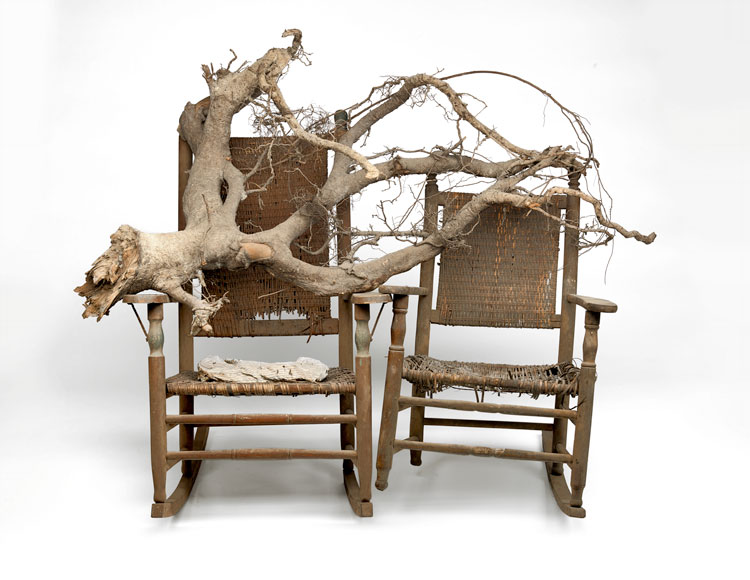
Lonnie Holley. Him and Her Hold the Root, 1994. 45 1/2 x 73 x 30 1/2 in. Collection: Fine Arts Museums of San Francisco. © Lonnie Holley / Artists Rights Society (ARS), New York. Photo: Stephen Pitkin/Pitkin Studio.
Among Holley’s contribution is his poignant 1994 sculpture Him and Her Hold the Root, comprising a gnarled tree root stretching across two worn rocking chairs, recalling an elderly couple on a porch and the deep, traumatic roots of their ancestry. His powerful music video I Woke Up in a Fucked-Up America is also included in the show, for besides being a sculptor, Holley is a talented musician, poet, educator, sage and visionary.
He made his professional debut in 2012, aged 62, and two years ago released his third album, MITH, to acclaim. He has played with the bands Animal Collective, Deerhunter and Bon Iver, and performed at a host of art and music venues, including the Metropolitan Museum of Art, the Whitney Museum of American Art, the Newport Folk Festival and the Meltdown Festival in London.
Like his art, Holley’s largely improvised music has a startling rawness and originality. Against a backdrop of ominous-sounding trombones and clashing drums, the video for I Woke Up shows the artist on a metal bedstead in his studio surrounded by miscellanea: statues of liberty, tyres, pistols, busts of Abraham Lincoln, lawn jockeys (small racially caricatured statues of African Americans used as lawn ornaments), globes, a US eagle chained in a bird cage, nets (a common motif in Holley’s work, symbolising the capture of Africans into slavery, as well as physical and mental captivity). It ends with Holley curled in a foetal position, naked but for myriad bracelets, rings and necklaces crying: “Let Me Out of This Dream.”
Interviewing Holley is a challenge as he speaks almost in a stream of consciousness, inventing evocative words, and veering off on vertiginous tangents that at times contain nuggets of profound wisdom – which Arnett scribbles down as potential future songs. “Humans” are frequently mentioned in the third person, as if Holley were observing mankind from outside. From under lockdown in Atlanta, he spoke with me by WhatsApp video about the environment, the coronavirus, his life and art.
Elizabeth Fullerton: What is your take on these strange times we are living through?
Lonnie Holley: There’s so much happening right now. What I’m afraid of is the containment of this, the aftermath of this stuff. It’s being flushed away somewhere, isn’t it? Think about that, all of the viral parts have to go somewhere. Even the clothing of the doctors, the water that washes the seats. What happens after the human is dead? That’s how inquisitive I am. My brain never stops. I want to find out and I will find out.
We have to see that we have as humans caused this planet to be wounded and its critical conditions are causing great effects like volcanoes erupting and earthquakes breaking out in ways we don’t understand. We’re having such storms and hurricanes and tornadoes. We had a lot of acres that burned across the globe, and you have to think about the deathly matter left and all of that having to be washed down when the next harsh rain comes, and then we have creatures that still have to drink this affected water. And nobody wants to really deal with this stuff. I think this is a call for togetherness. And this type of togetherness is going to render the Mothership a lot safer place to live on.
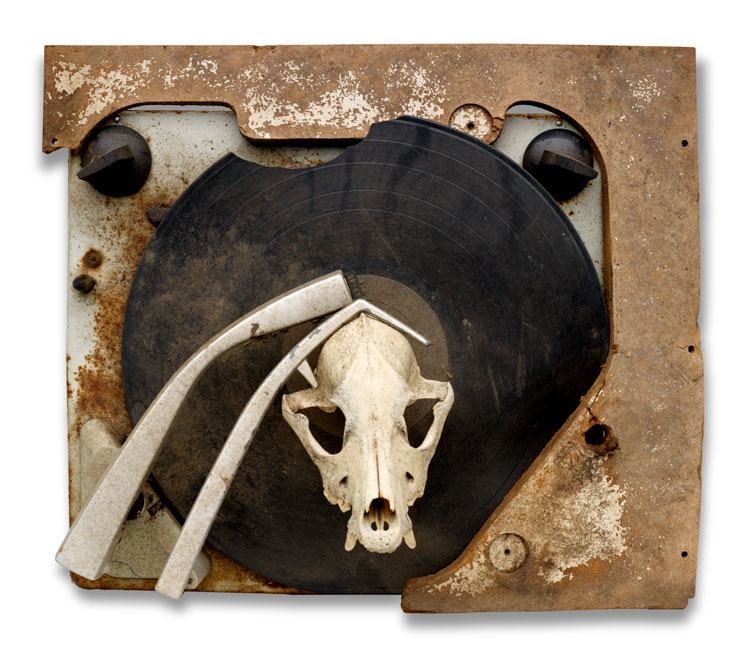
Lonnie Holley. Keeping a Record of It (Harmful Music), 1986. 13 3/4 x 15 3/4 x 9 in. Collection: Souls Grown Deep Foundation. © Lonnie Holley / Artists Rights Society (ARS), New York. Photo: Stephen Pitkin/Pitkin Studio.
EF: How can we make that happen?
LH: The other day I did a song about us paying attention. We have to learn to pay attention. Most people have been governed by attorneys and leaders and administrators. But you can learn something from a homeless person or from a new baby. I try to learn from anything I can put my hands on. That’s all I had as a little boy – nothing but pictures because I couldn’t read or write. The pictures are evidence.
EF: What keeps you going?
LH: I try to keep working and working because I know that humans still need a lot of the evidence that I have evidenced. And they will be able to either see it in the films that have been done about me or in the music that I sing out to them, because I’m still the same artist whether I’m making art or music. It’s coming from the same part of my brain, like Siamese twins. I’m not a rock star. I’m an artist that is interested in the humanities. All the stuff you see here behind me, a lot of people still call it junk, garbage, trash and debris, and, in a sense, it is from that source. All of my art came from there in order to reflect the truth of what those things are and how we as humans see them as accountable for the problems that we’re having.
EF: Your studio is filled with a profusion of hanging objects.
LH: It’s years of work. It’s going to go all the way up to the ceiling. A lot of what you see are springs, hair, nets. I love nets because we are involved with the internet. The internet is designed to catch our minds, but the nets that we throw out to catch fishes and all these other things, they come in many sizes.
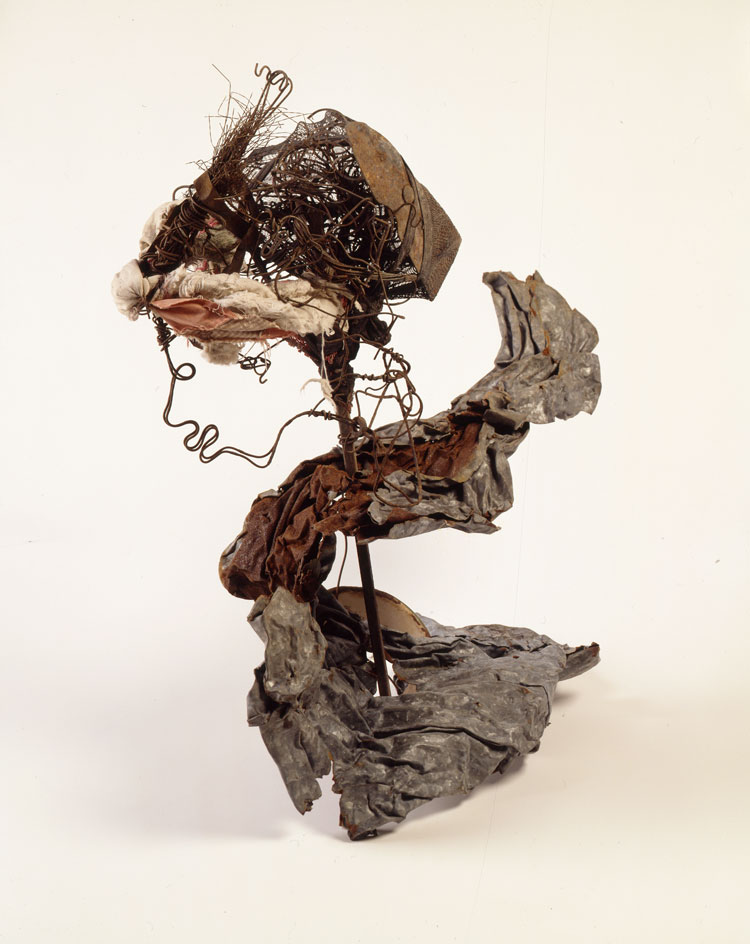
Lonnie Holley. Finally Getting Wings for the Forty-First Floor, 1996. 32 x 31 x 16 1/2 in. Collection: High Museum of Art. © Lonnie Holley / Artists Rights Society. (ARS), New York. Photo: Stephen Pitkin/Pitkin Studio.
EF: What got you started repurposing materials?
LH: I started doing my work with a knife, fork and a spoon on sandstone. It was used for the inner core lining of the moulds in the big steel factories. My grandfather Willie Holley had an ox and a wagon and he would carry iron ore from the mines to the factories. My grandpa was a recycler, he built an 18-room house out of objects he found on the side of the railroad coming from work to his new piece of land. He picked up every small rock, stone, brick – anything he could find – to make the foundation, so all of that was there for me to study. A lot of people said that I was possessed by his spirit because I was interested in the way he had done things.
EF: In your creative process, which comes first the idea, the material or the site?
LH: It’s according to the requirement of the space I’m going to be exhibiting in, according to what the material is offering to my thinking. And what the meaning is going to be to the humans that see it. The materials suggest different uses instead of just throwing them away.
All of these ideas are actually hand-downs and hand-downs. I remember my ma used to shuck the corn. And after shucking the corn, she would get that little bitty thread that looks like hair, she didn’t throw that away. She’d put it out to dry. She’d make dolls out of it. And Grandpappy would sit up and whittle out the cob and make corn pipes with just a little bitty piece of bamboo.
EF: Do you go out looking for your materials or do they find you?
LH: Once upon a time, I would spend half of the day just going out looking for materials. I started gathering materials in 1979 and this is 2020. I’ve gathered so much.
EF: So now you have enough materials to work with …
LH: Oh no, I don’t want to say that now. I got enough materials to keep me content in case I can’t get out to gather. I’m always interested in learning, in seeing what else is available. A lot of times I may pick up something and it may take a year or six months before I even put my thought to it or find the other components to go with it. My grandchildren say Grandaddy is a hoarder but, in these days where young people see things as trash, I’m trying to get them to understand they should identify additional uses for them, use them to expand their mind. Sometimes, I even take a sledgehammer and bust something open just to see what’s inside of it.
EF: How have your interests changed over the years?
LH: A lot of the things I’m interested in now are what I was interested in at five years old when I was made to go and dig worms because they didn’t want me watching the people come in and getting their shot of liquor. I had fun. I started playing with the worms and crawdads [crayfish] and tadpoles. I got a chance to see the minnows and crawling things underneath the plants and the rocks and all of the stuff that is flushed down the street.
I find myself still craving to return to the creeks and the ditches, the sewers and the waterways. I’m seeing a lot, lot worse washed down now than I ever saw before. It’s clogged up. I’m seeing plastic everywhere, the roots of the trees being tangled by different type of debris, hair, particles from ropes.
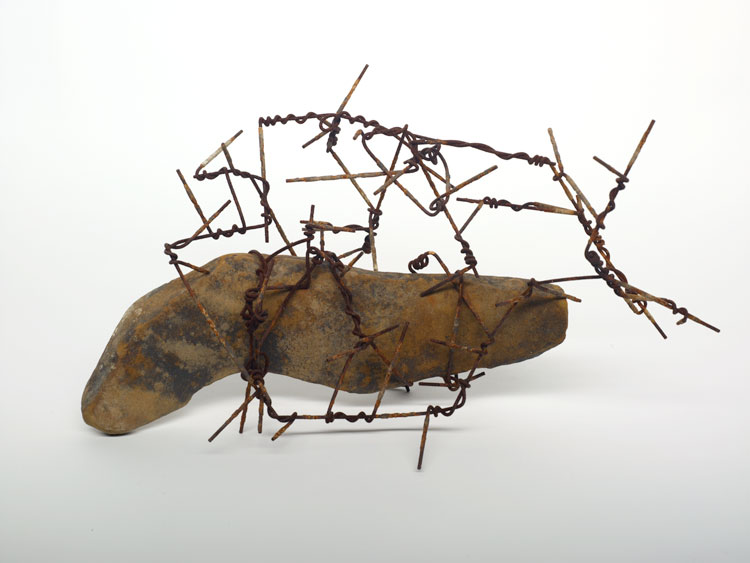
Lonnie Holley. Tying Up the Rock, 1994. 12 x 23 x 13 in. Collection: Souls Grown Deep Foundation. © Lonnie Holley / Artists Rights Society (ARS), New York. Photo: Stephen Pitkin/Pitkin Studio.
EF: You have been through hard times that might have defeated even the most resilient spirits. Where did you find inspiration?
LH: It was harsh experiences, experiences that almost took my life. Someone like Matt Arnett, before that Matt’s father, William Arnett, and others. Before them were my grandaddy and my mother having 27 children out of 32 pregnancies. All of these are examples of how you have to make it by any means. My grandmother, going to the landfill for scrap from early in the morning to noon, she’d bring the load home, go to the cemetery and work digging graves till the evening, then come home and prepare food for the family members. These examples allowed me to say: “OK, I can get down to the nitty gritty of digging a grave or of going to landfill”, where you got smoke from burning excess materials. I was seeing these being dumped by the city garbage trucks by the minute, lined up behind each other. But someone like myself or Joe Minter, we take all of the little bitty, down to the nuts and bolts, and put it back together in a form of art. You’re going to have to break things all the way down to the motherboard in order to understand the Mothership.
EF: Do you feel art saved you?
LH: Yes, I do. Thinking about the periods where I was abused, mistreated. When I was four, that was probably my first really painful experience. I had a red-hot poker iron driven into my head about a little finger deep. I had to be rushed to hospital. Then there was when I got hit by a car and dragged underneath for two and a half blocks. When I got healed enough to send me back to the whiskey house, I ran away and took the freight train, wrapped up in quilts on the roof, and woke up in New Orleans. Those experiences were all talked about, written about and suffered about. I did a piece, The Spirit of My Grandmother Wrapped in the Blanket of Time (1987), honouring my grandmother because of that, thinking about the past and the old ways.
To rewind this situation: Did art save your life? Or did your knowing of your artistic ability save your life? I was a little tiny judge, not knowing that I was a judge all the time, judging capabilities, possibilities of hope, and then I developed on through the hardships of Alabama Industrial School for Negro Children, getting whupped every day.
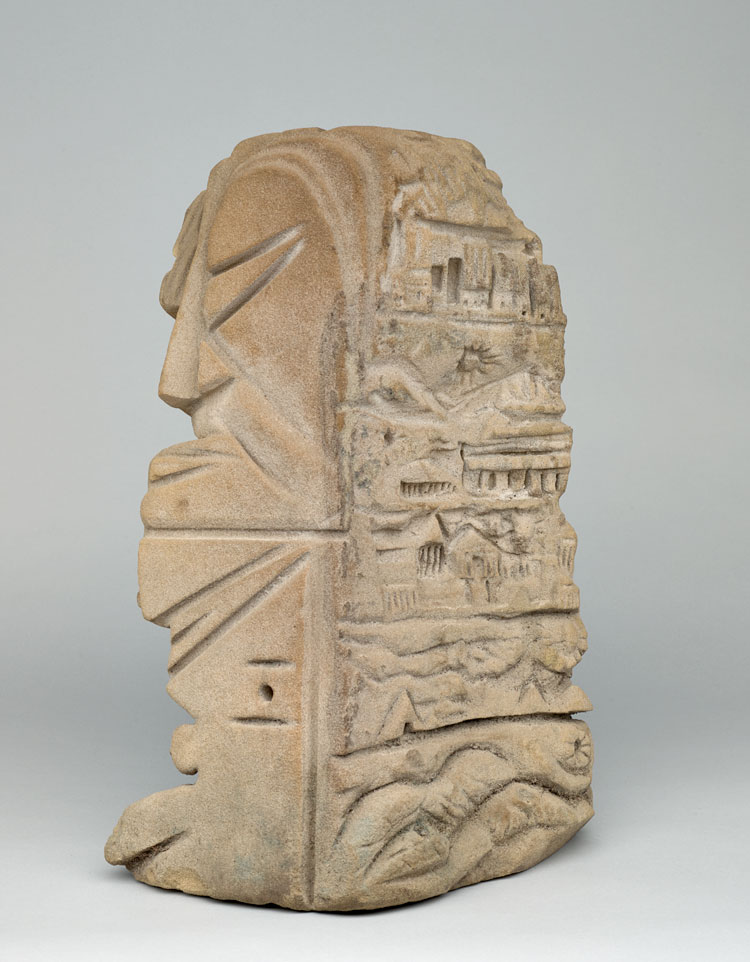
Lonnie Holley. From the Beginning to the End of the Beginning, 1985. 23 x 12 x 9 1/2 in. Collection: Souls Grown Deep Foundation © Lonnie Holley / Artists Rights Society (ARS), New York. Photo: Stephen Pitkin/Pitkin Studio.
EF: Do you draw any positives from these experiences?
LH: It made me stronger, it made me wiser, it made me more care-full. Careful and care-full are two different words. Caring for humanity because I’m interested in the whole line of humanity.
EF: In one brutal episode at the juvenile facility, you recalled being beaten until your legs bled and you were set on top of a rock pile as an example. How do you process your feelings around something like that in your art?
LH: The way I do that is to fasten all of that emotion right there in that rock pile and visualise in my mind that blood running down the rock. I have to take some old rag and a wagon and go back to me getting hit by that car and dragged underneath. I have to take all that consideration and put it on to that wagon, nail it down tight and put a block of wood on there, because that was my intention when I got hit, to go down the street and get a wagon full of wood. And you see how I put things together now as a way to memorialise them.
EF: You are often referred to as an outsider or self-taught artist. How do you describe yourself?
LH: I didn’t want to be outside of nothing. We been considered to be outside quicker than we been considered to be artists of America. I wanted to be an American artist. All these titles fitted me like an ill-fitting suit. I’ve worn them proudly because that was the only thing I had to wear. But otherwise, I want people to see that I’m hopefully one of America’s greater artists. I think as material use is concerned, I’ve really, really broke the record. I haven’t been listed in the Guinness World Records, but if they did a record on my life and Thornton Dial’s life and Joe Minter’s life and the Gee’s Bend Quilters’ life, then we would fit into a different category because we would have given them a different definition of material, us being the studiers of these materials that other people saw fit not to study.
EF: Your new album, MITH, was widely feted; it seems to have resonated with the times.
LH: Wow. That album seems like it is just coming to fruition more every second. Everything that I’ve sung on that is boiling like a big old pot of gumbo, you know that you have to stir. Every time I look around, something new about the album MITH is coming into fullness. It’s like I was looking in a crystal ball. I pretty well sung about everything that now is occurring. It’s just really scary if you think about it. A lot of times we put fiction on, we want something prettier, more comfortable for us to digest. But that’s not the picture on the Mothership.
I can’t do anything now but shed teardrops for those deaths. What is written in a teardrop? Can we understand the language of a teardrop? That may be something I sing when I come back to Europe, I can see Matt writing it down.
EF: What gave rise to I Woke Up in a Fucked-Up America?
LH: It’s partly a historical point of view because not only have African Americans been separated from where we were, we might have went to sleep or got knocked unconscious in Africa, and then we were thrown on to the slave ships and woke up in a fucked-up America. But then there’s one song, I Snuck Off the Slave Ship (in my imagination ). If you listen to one song after the other, you’ll hear chapter one, two, three, four. That’s almost like the biblical pages itself; those are my chapters of information.
EF: Do you see yourself as having a responsibility to pass on a message?
LH: It’s like me going out and making sure there’s enough wood in the kitchen for the stove to cook the food, or running around miles with my oldest brother early in the morning to get the children to kindergarten before going to school ourselves. All of that played a role in preparation for me to be an educator.
EF: Your solo exhibition at Edel Assanti, which had been due to run from March to May this year, has been postponed until January 2021. How far had you planned your show?
LH: We almost got everything we gonna have. We have a work ladder with paint splattered over that’s gonna have about 50 insides of high heel shoes attached to it, making it impossible to climb up, called something like “Trying to Survive in His World”. And we have a door with a root breaking out of it like a sci-fi movie. This virus made me think of the film The Day the Earth Stood Still (1951), not just from the sci-fi perspective but from our technical involvement, too.
EF: What projects have you got longer term?
LH: A lot of my life is to make preparation for if there’s ever to be a Lonnie Holley museum. I would prefer to have some acres not too far from a landfill where I can just get what I need and put it together and have a way that students can walk to that. What I’m doing is going to be more a research centre than just a museum. It’s a huge project and I just have to find somebody who wants to get behind it. Don’t you think so?